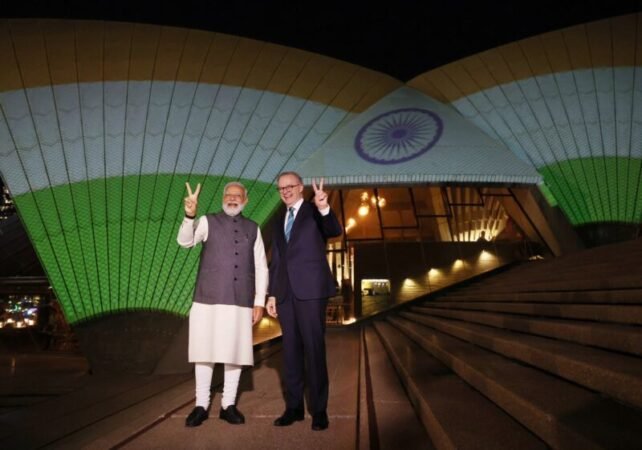Dust Settles on Modi’s Oz Visit! So, How Much Dust Did Blow?

On May 23, PM Modi’s Sydney visit formed part of the third and last leg of his three-nation tour after he ended his Papua New Guinea visit. This was Modi’s first visit to Australia after a nine-year gap.
What does his reception in the country indicate?
The dust has now settled over PM Narendra Modi’s three-day Australia visit and his much-hyped Sydney diaspora event. Well, not too much dust at that, if reports in certain sections of the media are to be believed.
“Upon entering the stadium, I could immediately see empty chairs scattered throughout the expansive venue,” writes one correspondent for online portal The Wire, who is a journalist and author based in Australia. “The section near the stage, where I had entered, was densely packed with attendees, although finding a seat was easy. However, on the other side of the stage, the first level was only half-filled, while people occupied sporadic spots on the second and fourth levels. A significant number of chairs remained unoccupied in that area. This struck me as surprising, since the tickets had been distributed for free, and registration had been actively promoted through WhatsApp groups for weeks. Curiously, there seemed to be a veil of secrecy surrounding the ticket distribution process, lending an air of privacy to the entire event,” he adds.
In April, WhatsApp was inundated with messages announcing a programme titled ‘Australia Welcomes Modi’, to be organized by an ‘unknown’ entity called the Indian Australian Diaspora Foundation (IADF), adds the correspondent. A search for details about the organization, including its ownership and website, finally revealed that it had registered itself only as recently as in February.
But Australia abounds in Modi supporters. More than 350 organizations were said to have signed up for the event. A fortnight before the actual event took place, the IADF announced that more than 20,000 individuals (sic!) had registered where the stadium had a capacity of only 18,500 seats with no place for the general public, says The Wire correspondent.
Large screens were to be installed outside the stadium for the ticketless unfortunates to allow them to watch the proceedings, signalling there would be no space even to stand in the aisles inside. “The hall was nearly half-empty,” writes the correspondent, “including the section designated for VIP guests, leaving people perplexed about the abundance of unoccupied seats,” even as an emcee on stage announced the arrival of 25,000 people. Really 25,000 in a stadium with a capacity of only 18,500—with empty seats going a-begging?!
Admits the correspondent, however, the Australian government “actively participated in the event” with several prominent ministers in tow. Prime Minister Anthony Albanese even hailed PM Modi as “the boss”. People had come all the way from from capital Canberra, Melbourne and Brisbane in chartered buses and a flight aptly named ‘Modi Airways’!
Pranesh Prasad, a lawyer and author based in Australia, disputes this view. “The event proved to all in this country—especially those in government, media and businesses—that, despite his detractors, Modi’s popularity remains intact. But, more importantly, the Indian population in Australia is a professional, successful and highly positive influence in the melting pot of Australia’s multicultural society. The secrecy that purportedly shrouds ticket distribution and the question whether the venue was filled to capacity or not are not at all relevant to Modi’s visit,” he says. “The event, in itself, was important since it saw a firming up of India-Australia partnership.”
Prasad goes on to add, “The event put the spotlight on Indians here as a force not to be trifled with. The Sydney Harbour Bridge and the Opera House were illuminated in the colours of the Tiranga to welcome Modi, who visited the iconic landmarks. Do you think Pakistan could have achieved that?” PM Albanese had wanted a projection of the Indian National Flag on the building to highlight Modi’s visit, says the Sydney Morning Herald—a gesture which did not mark King Charles III’s coronation.
“Modi’s visit, for Australia, signifies the high point in bilateral relationship,” says Prasad. “China is seen as economic partner, but never a security partner, while India is seen as both. Two-way trade between the two countries is valued at $ 46.5 billion and, with initiatives signed during Modi’s visit—such as the joint green hydrogen taskforce and so forth—it will only increase.
“Another initial signed was the Migration and Mobility Partnership Agreement,” says Pranesh Prasad, “which not only makes it easier for students, academics and professionals to live, study and work in each other’s countries but 3,000 Indian professionals in highly skilled areas can also move to Australia for two years without employer sponsorship. Australia earlier offered these opportunities only to ‘white’ countries.”
“India is seen as a major power on its way to greater things,” concludes Pranesh Prasad. “We may not be quite a superpower yet, but our time will come (apna time aayega). The human rights, censorship, minorities, Hindu fundamentalist angle and Modi Gujarat riots stuff is played here by the Left just as in India. Traditionally, Australia—despite everything—is still pro-China at the people-to-people and media levels. So, such programmes as Modi’s stadium event help to change perception. One Chinese friend said to me that, if any of China’s top leaders came here, they would be lucky to have even a few people turning up. The total capacity of Sydney venue is 21,302. The Australian media itself reported 20,000 turnout. So, who cares?”


















